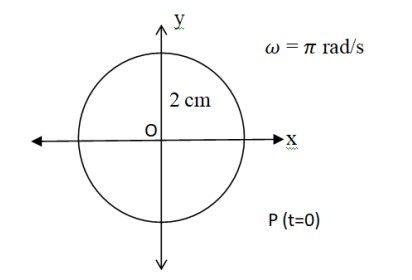
Oscillations Class 11 Physics covers the motion of the object to and fro about a mean position, similar to the pendulum of a wall clock. Such motion is called the oscillatory motion. Other examples of the oscillatory motion include the piston in a steam engine going back and forth, and a boat tossing up and down in a river.
Oscillations Class 11 NCERT Solutions are important for students as the concept of the oscillatory motion is basic to physics, and its understanding is important for many physical phenomena. The key concepts of this chapter include the frequency, period, amplitude, displacement, and phase. The experts at Shiksha created these solutions to help students understand the concepts clearly and achieve great success in their Class 11 exams, CBSE Board, and other entrance tests like NEET and JEE Main.
Students can access the comprehensive NCERT solutions for Class 11 and Class 12 of three subjects - Physics, Chemistry, and Maths at NCERT Solutions Class 11 and 12.
- NCERT Class 11 Physics Oscillation: Weightage, Key Topics
- Important Formulas of Oscillations Class 11
- NCERT Physics Class11th Solution for Oscillations PDF Download
- Chapter 13 Oscillations Important Formulas & Concepts
- NCERT Physics Class11th Oscillations Solutions
NCERT Class 11 Physics Oscillation: Weightage, Key Topics
Important topics of Oscillations Class 11 include time period, amplitude, and frequency of oscillations, Simple Harmonic Motion (SHM), Energy in SHM, law of simple pendulum, wave motion, including types of waves, damped and forced oscillations, standing waves, superposition of waves, and Doppler effect. See below the topics covered in this chapter:
| Exercise | Topics Covered |
|---|---|
| 13.1 | Introduction |
| 13.2 | Periodic and Oscillatory Motions |
| 13.3 | Simple Harmonic Motion |
| 13.4 | Simple Harmonic Motion and Uniform Circular Motion |
| 13.5 | Velocity and Acceleration in Simple Harmonic Motion |
| 13.6 | Force Law for Simple Harmonic Motion |
| 13.7 | Energy in Simple Harmonic Motion |
| 13.8 | The Simple Pendulum |
Oscillations Class 11 Weightage in NEET, JEE Main exam
| Exam | Number of Questions | Weightage |
|---|---|---|
| JEE Main | 2-3 questions | 9% |
| NEET | 1-3 questions | 3% to 7% |
Important Formulas of Oscillations Class 11
The following are important formulas of this chapter:
| Physical Quantity | Symbol | Formula |
|---|---|---|
| Frequency | v | |
| Angular Frequency | ||
| Force Constant | k |
Related Links
| NCERT Notes for Class 11 & 12 | NCERT Class 11 Notes | Class 11 Physics Notes |
NCERT Physics Class11th Solution for Oscillations PDF Download
It is recommended for students to download the oscillations class 11 NCERT PDF from the link given below. It offers accurate and reliable study material for the school exam, CBSE Board, and competitive exam preparation.
Download Here: NCERT Solution for Class XI Physics Chapter Oscillation PDF
Chapter 13 Oscillations Important Formulas & Concepts
Important Formulae of Oscillations for CBSE & Competitive Exams
- Equation of SHM:
Where is amplitude, is angular frequency, and is phase constant - Velocity in SHM:
- Acceleration in SHM:
- Time Period of a Spring-Mass System:
- Time Period of a Simple Pendulum:
- Total Energy in SHM:
- Angular Frequency:
- Energy Distribution:
-
Kinetic Energy:
-
Potential Energy:
-
NCERT Physics Class11th Oscillations Solutions
| Q.14.1 Which of the following examples represent periodic motion? (a) A swimmer completing one (return) trip from one bank of a river to the other and back
(b) A freely suspended bar magnet displaced from its N-S direction and released
(c) A hydrogen molecule rotating about its centre of mass
(d) An arrow released from a bow |
| Ans.14.1 (a) The swimmer’s motion is not periodic. The motion of the swimmer between the banks of a river is back and forth. However, it does not have a definite period. This is because the time taken by the swimmer during his back and forth journey may not be the same.
(b) The motion of a freely-suspended magnet, if displaced from its N-S direction and released, is periodic. This is because the magnet oscillates about its position with a definite period of time.
(c) When a hydrogen molecule rotates about its centre of mass, it comes to the same position again and again, after an equal interval of time. Such motion is periodic.
(d) An arrow released from a bow moves only in the forward direction. It does not come backward. Hence this motion is not a periodic. |
| Q.14.2 Which of the following examples represent (nearly) simple harmonic motion and which represent periodic but not simple harmonic motion? (a) The rotation of earth about its axis.
(b) Motion of an oscillating mercury column in a U-tube.
(c) Motion of a ball bearing inside a smooth curved bowl, when released from a point slightly above the lower most point.
(d) General vibrations of a polyatomic molecule about its equilibrium position. |
| Ans.14.2 (a) During its rotation about its axis, earth comes to the same position again and again in equal intervals of time. Hence it is a periodic motion. However, this motion is not simple harmonic, as earth does not have to and fro motion about its axis.
(b) An oscillating mercury column in a U-tube is simple harmonic. This is because the mercury moves to and fro on the same path, about the fixed position, with a certain period of time.
(c) The ball moves to and fro about the lowermost point of the bowl when released. Also the ball comes back to its initial position in the same period of time, again and again. Hence, its motion is periodic as well as simple harmonic.
(d) A polyatomic molecule has many natural frequencies of oscillations. Their vibration is the superposition of individual simple harmonic motion of a number of different molecules. Hence, it is not simple harmonic, it is periodic. |
| Q.14.3 Fig. 14.23 depicts four x-t plots for linear motion of a particle. Which of the plots represent periodic motion? What is the period of motion (in case of periodic motion)? |
| Ans.14.3 (a) It is not a periodic motion. It represents a unidirectional, linear uniform motion. There is no repetition of motion
(b) In this case, the motion of the particle repeats itself after 2 s. Hence, it is a periodic motion, having a period of 2 s
(c) It is not a periodic motion. This is because the particle repeats the motion in one position only. For a periodic motion, the entire motion of the particle must be repeated in equal intervals of time
(d) In this case, the motion of the particle repeats itself after 2 s. Hence, it is periodic motion, having a period of 2 s |
| Q.14.4 Which of the following functions of time represent (a) simple harmonic, (b) periodic but not simple harmonic and (c) non-periodic motion? Give period for each case of periodic motion ( is any positive constant): (a) Sin t – cos t (b) Sin3 t (c) 3 cos ( /4 – 2 t) (d) Cos t + cos 3 t + cos 5 t (e) Exp (– 2t2) (f) 1 + t + 2t2 |
| Ans.14.4 (a) The given function is sin t – cos t = = = ) This function represents SHM as it can be written in the form: a sin ( t + ) Its period is . It is periodic, but not SHM
(b) Sin3 t = The terms t and t individually represents simple harmonic motion. However, the superposition of two SHM is periodic but not simple harmonic.
(c) The given function is 3 cos ( /4 – 2 t) = -3cos(2 t - /4) This function represents simple harmonic motion because it can be written in the form: a cos( ), its time period is = . Periodic but not SHM
(d) The given function is cos t + cos 3 t + cos 5 t – Each individual cosine function represents SHM, however the superposition of three SHM is periodic but not simple harmonic.
(e) The given function exp (– 2t2) is an exponential function. Exponential functions do not repeat themselves, hence non-periodic motion.
(f) The given function 1 + t + 2t2 is non-periodic. |
Commonly asked questions
14.1 Which of the following examples represent periodic motion?
(a) A swimmer completing one (return) trip from one bank of a river to the other and back
(b) A freely suspended bar magnet displaced from its N-S direction and released
(c) A hydrogen molecule rotating about its centre of mass
(d) An arrow released from a bow
(a) The swimmer's motion is not periodic. The motion of the swimmer between the banks of a river is back and forth. However, it does not have a definite period. This is because the time taken by the swimmer during his back and forth journey may not be the same.
(b) The motion of a freely-suspended magnet, if displaced from its N-S direction and released, is periodic. This is because the magnet oscillates about its position with a definite period of time.
(c) When a hydrogen molecule rotates about its centre of mass, it comes to the same position again and again, after an equal interval of time. Such motion is periodic.
(d) An arrow released from a bow moves only in the forward direction. It does not come backward. Hence this motion is not a periodic.
14.2 Which of the following examples represent (nearly) simple harmonic motion and which represent periodic but not simple harmonic motion?
(a) The rotation of earth about its axis.
(b) Motion of an oscillating mercury column in a U-tube.
(c) Motion of a ball bearing inside a smooth curved bowl, when released from a point slightly above the lower most point.
(d) General vibrations of a polyatomic molecule about its equilibrium position.
(a) During its rotation about its axis, earth comes to the same position again and again in equal intervals of time. Hence it is a periodic motion. However, this motion is not simple harmonic, as earth does not have to and fro motion about its axis.
(b) An oscillating mercury column in a U-tube is simple harmonic. This is because the mercury moves to and fro on the same path, about the fixed position, with a certain period of time.
(c) The ball moves to and fro about the lowermost point of the bowl when released. Also the ball comes back to its initial position in the same period of time, again and again. Hence, its motion is periodic as well as simple harmonic.
(d) A polyatomic molecule has many natural frequencies of oscillations. Their vibration is the superposition of individual simple harmonic motion of a number of different molecules. Hence, it is not simple harmonic, it is periodic.
14.3 Fig. 14.23 depicts four x-t plots for linear motion of a particle. Which of the plots represent periodic motion? What is the period of motion (in case of periodic motion)?
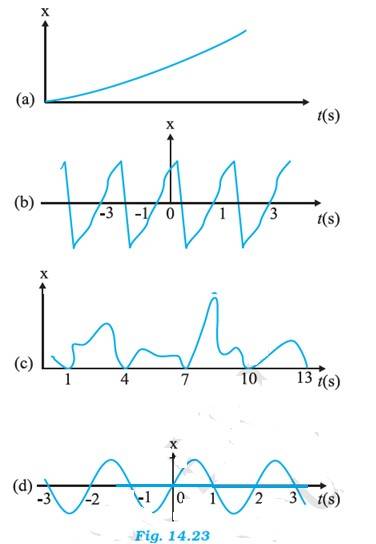
(a) It is not a periodic motion. It represents a unidirectional, linear uniform motion. There is no repetition of motion
(b) In this case, the motion of the particle repeats itself after 2 s. Hence, it is a periodic motion, having a period of 2 s
(c) It is not a periodic motion. This is because the particle repeats the motion in one position only. For a periodic motion, the entire motion of the particle must be repeated in equal intervals of time
(d) In this case, the motion of the particle repeats itself after 2 s. Hence, it is periodic motion, having a period of 2 s
14.4 Which of the following functions of time represent (a) simple harmonic, (b) periodic but not simple harmonic and (c) non-periodic motion? Give period for each case of periodic motion ( is any positive constant):
(a) Sin t – cos t
(b) Sin3 t
(c) 3 cos ( /4 – 2 t)
(d) Cos t + cos 3 t + cos 5 t
(e) Exp (– 2t2)
(f) 1 + t + 2t2
(a) The given function is sin t – cos t
= =
= )
This function represents SHM as it can be written in the form: a sin ( t + )
Its period is . It is periodic, but not SHM
(b) Sin3 t =
The terms t and t individually represents simple harmonic motion. However, the superposition of two SHM is periodic but not simple harmonic.
(c) The given function is 3 cos ( /4 – 2 t) = -3cos(2 t - /4)
This function represents simple harmonic motion because it can be written in the form: a cos( ), its time period is = . Periodic but not SHM
(d) The given function is cos t + cos 3 t + cos 5 t – Each individual cosine function represents SHM, however the superposition of three SHM is periodic but not simple harmonic.
(e) The given function exp (– 2t2) is an exponential function. Exponential functions do not repeat themselves, hence non-periodic motion.
(f) The given function 1 + t + 2t2 is non-periodic.
14.5 A particle is in linear simple harmonic motion between two points, A and B, 10 cm apart. Take the direction from A to B as the positive direction and give the signs of velocity, acceleration and force on the particle when it is
(a) At the end A
(b) At the end B
(c) At the mid-point of AB going towards A
(d) At 2 cm away from B going towards A
(e) At 3 cm away from A going towards B
(f) At 4 cm away from B going towards A
a)

The given situation is shown in the figure. Points A and B are the two end points, with AB = 10 cm. O is the midpoint of the path. A particle is in linear simple harmonic motion between the end points. At the extreme point A, the particle is at rest momentarily. Hence, its velocity is zero at this point. Its acceleration is positive as it is directed along AO. Force is also positive in this case as the particle is directed rightward.
(b) At the extreme point B, the particle is at rest momentarily. Hence, its velocity is zero at this point. Its acceleration is negative in this case as it is directed along B. Force is also negative as it is directed leftward.
(c)

The particle is executing a simple harmonic motion. O is the mean position of the particle. Its velocity at the mean position O is the maximum. The value for velocity is negative as the particle is directed leftward. The acceleration and force of a particle executing SHM is zero at the mean position.
(d)

The particle is moving towards point O from the end B. This direction of motion is opposite to the conventional positive direction, which is from A to B. Hence, the particle's velocity and acceleration, and the force on it are all negative.
(e)
The particle is moving towards point O from the end A. This direction of motion is from A to B, which is the conventional positive direction. Hence, the values for velocity, acceleration and force are all positive.
(f)
The particle is moving towards point O from the end B. This direction of motion is opposite to the conventional positive direction, which is from A to B. Hence, the particle's velocity and acceleration, and the force on it are all negative.
14.6 Which of the following relationships between the acceleration a and the displacement x of a particle involve simple harmonic motion?
(a) A = 0.7x
(b) A = –200x2
(c) A = –10x
(d) A = 100x3
A motion represents simple harmonic motion if it is governed by the force of law
F = ma, where F is the force, m is the mass and a is the acceleration and F = kx, where k is a constant among given equation and x is the displacement.
We can write a = x
Only equation a = -10x is written in this form. Hence this relation represents SHM. The answer is option (c).
14.7 The motion of a particle executing simple harmonic motion is described by the displacement function,
x(t) = A cos ( t + ).
If the initial (t = 0) position of the particle is 1 cm and its initial velocity is cm/s, what are its amplitude and initial phase angle ? The angular frequency of the particle is s–1. If instead of the cosine function, we choose the sine function to describe the SHM : x = B sin ( t + ), what are the amplitude and initial phase of the particle with the above initial conditions.
Initially at t =0, Displacement, x = 1 cm
Initial velocity, v = cm/s, Angular frequency, = rad/s
It is given that: x(t) = A cos ( t + )
Then 1 = A cos (
A cos = 1 ….(i)
Velocity, v =
1 = -Asin(
Asin ………(ii)
Squaring and adding equations (i) and (ii), we get
= 1+1
A = cm
= -1
Then = , ,,,
SHM is given as X = Bsin( t + )
Putting the given values in this equation, we get
1 = Bsin( )
Bsin =1…….(iii)
Velocity V = Bcos( t + )
Substituting the given values, we get = Bcos or B = 1 …..(iv)
Squaring and adding equations (iii) and (iv), we get
= 1+1
B =
Dividing equation (iii) by equation (iv), we get
= 1 or = 1
= ,
14.8 A spring balance has a scale that reads from 0 to 50 kg. The length of the scale is 20 cm. A body suspended from this balance, when displaced and released, oscillates with a period of 0.6 s. What is the weight of the body?
The maximum mass that the scale can read, M = 50 kg
Maximum displacement of the spring = Length of the scale, l = 20 cm = 0.2 m
Time period, T = 0.6 s
Maximum force exerted on the spring, F =Mg
g = acceleration due to gravity = 9.8 m/
Hence, F = 50 = 490 N
Spring constant k = = = 2450 N/
Mass m is suspended from the balance, hence time period, T =
m = ( = ( = 22.34 kg
Weight = mg = 218.944 N
So the weight of the body is about 219 kg.
14.9 A spring having with a spring constant 1200 N m–1 is mounted on a horizontal table as shown in Fig. 14.24. A mass of 3 kg is attached to the free end of the spring. The mass is then pulled sideways to a distance of 2.0 cm and released.
Determine
(i) The frequency of oscillations
(ii) Maximum acceleration of the mass
(iii) The maximum speed of the mass
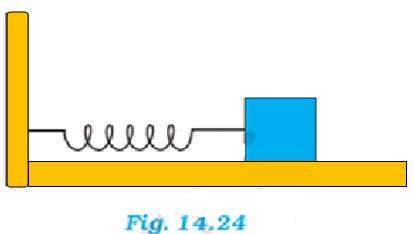
Spring constant, k = 1200 N/m
Mass, m = 3 kg
Displacement, d = 2 cm = 0.02 m
(a) Frequency of oscillation, v is given by
v = = = = 3.183 m/s
(b) Maximum acceleration (a) is given by the relation: a =
where, angular frequency = and A = maximum displacement
a = = = 8 m/
(c) Maximum velocity, = = 0.4 m/s
Hence the maximum velocity of the mass is 0.4 m/s
14.10 In Exercise 14.9, let us take the position of mass when the spring is unstretched as x = 0, and the direction from left to right as the positive direction of x-axis. Give x as a function of time t for the oscillating mass if at the moment we start the stopwatch (t = 0), the mass is
(a) At the mean position
(b) At the maximum stretched position
(c) At the maximum compressed position
In what way do these functions for SHM differ from each other, in frequency, in amplitude or the initial phase?
The functions have the same frequency and amplitude, but different initial phases.
Distance travelled by the mass sideways, A = 2.0 cm
Force constant of the spring, k = 1200 N/m and mass, m = 3 kg
Angular frequency, = = 20 rad/s
(a) When mass is at the mean position, displacement x = Asin cm
(b) At the maximum stretched position, the mass is towards extreme right. Hence the initial phase is
x = A sin ( = 2sin (20t + = 2cos20t
(c) At the maximum compressed position, the mass is towards the extreme left
Hence, the initial phase is
x = Asin ( = 2 cos20t
Hence, the functions have the same frequency and amplitude, but different initial phases.
14.11 Figures 14.25 correspond to two circular motions. The radius of the circle, the period of revolution, the initial position, and the sense of revolution (i.e. clockwise or anti-clockwise) are indicated on each figure.
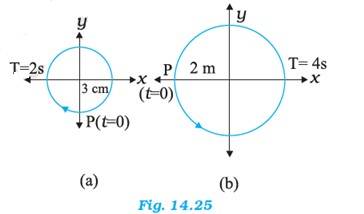
Obtain the corresponding simple harmonic motions of the x-projection of the radius vector of the revolving particle P, in each case.
(a) Time period, T = 2 s, Amplitude A = 3 cm
At time, t = 0, the radius vector makes an angle with the positive x-axis, i.e. phase angle = +
Therefore, the equation of simple harmonic motion for the x-projection of the radius vector, at time t is given by the displacement equation:
x = Acos = 3cos = -3sin ( ) = -3sin cm
(b) Time period, T = 4 s, Amplitude A = 2 m
At time, t = 0, the radius vector makes an angle with the positive x-axis, i.e. phase angle = +
Therefore, the equation of simple harmonic motion for the x-projection of the radius vector, at time t is given by the displacement equation:
x = Acos = 2cos = -2cos ( m
14.12 Plot the corresponding reference circle for each of the following simple harmonic motions. Indicate the initial (t =0) position of the particle, the radius of the circle, and the angular speed of the rotating particle. For simplicity, the sense of rotation may be fixed to be anticlockwise in every case: (x is in cm and t is in s).
(a) X = –2 sin (3t + /3)
(b) X = cos ( 6 – t)
(c) X = 3 sin (2 t + /4)
(d) X = 2 cos t
(a) X = -2 sin( 3t + ) = +2cos ( 3t + + = 2 cos (3t + )
when we compare this equation with standard SHM equation
x = Acos ( t + ), then we get
Amplitude A = 2 cm. Phase angle = 150 , angular velocity = 3 rad/s
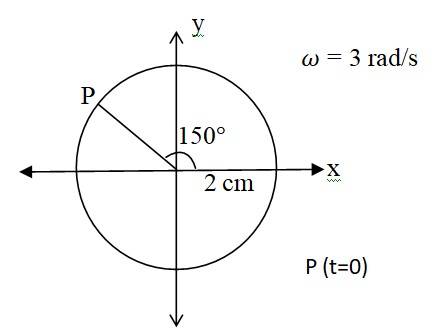
(b) X= cos ( t) = cos ( )
when we compare this equation with standard SHM equation
x = Acos( t + ), then we get
Amplitude A = 1 cm. Phase angle = - 30 , angular velocity = 1 rad/s
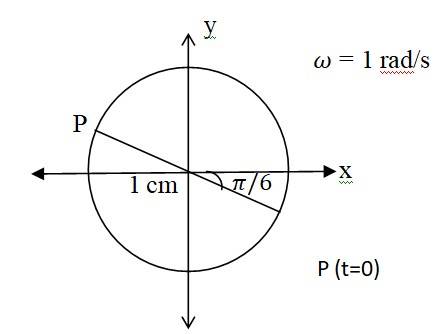
(c) X = 3sin (2 t + ) = -3cos
when we compare this equation with standard SHM equation
x = Acos( t + ), then we get
Amplitude A = 3 cm. Phase angle = 135 , angular velocity = rad/s
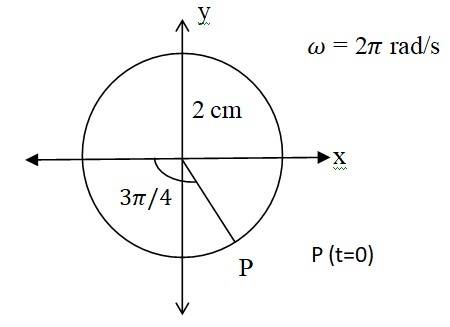
(d) X = 2cos t
when we compare this equation with standard SHM equation
x = Acos( t + ), then we get
Amplitude A = 2 cm. Phase angle , angular velocity = rad/s
14.13 Figure 14.26 (a) shows a spring of force constant k clamped rigidly at one end and a mass m attached to its free end. A force F applied at the free end stretches the spring. Figure 14.26 (b) shows the same spring with both ends free and attached to a mass m at either end. Each end of the spring in Fig. 14.26(b) is stretched by the same force F.
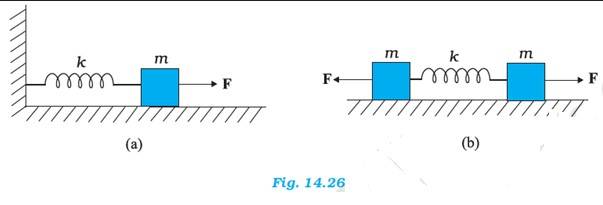
(a) What is the maximum extension of the spring in the two cases ?
(b) If the mass in Fig. (a) and the two masses in Fig. (b) are released, what is the period of oscillation in each case ?
(a) For figure (a) : When a force F is applied to the free end of the spring, an extension l is produced. For the maximum extension, it can be written as:
F – kl, where k is the spring constant.
For maximum =extension of the spring, l =
For figure (b): The displacement (x) produced in this case is x =
Net force F = +2kx = 2k . So l =
(b) For figure (a) : For mass (m) of the block, force is written as : F = ma = m ,
where x is the displacement of the block in time t, then
m , it is negative because the direction of the elastic force is opposite to the direction of displacement.
= xwhere, = ,
Time period of the oscillation, T = = = 2
For figure (b) :
F = m = -2kx. It is negative because the direction of elastic force is opposite to the direction of displacement.
= - x, where angular frequency =
Time period, T =
14.14 The piston in the cylinder head of a locomotive has a stroke (twice the amplitude) of 1.0 m. If the piston moves with simple harmonic motion with an angular frequency of 200 rad/min, what is its maximum speed ?
Angular frequency of the piston,
Stroke = 1 m
Amplitude, A = Stroke/2 = 0.5 m
The maximum piston speed, A = 200 = 100 m/min
14.15 The acceleration due to gravity on the surface of moon is 1.7 m s–2. What is the time period of a simple pendulum on the surface of moon if its time period on the surface of earth is 3.5 s ? (g on the surface of earth is 9.8 m s–2)
Acceleration due to gravity on Moon surface, g’ = 1.7 m/
Acceleration due to gravity on Earth surface, g = 9.8 m/
Time period on Earth, T = 3.5 s
We know T = 2 where l = length of the pendulum
l = = = 3.041 m
On Moon surface, the length of the pendulum remained same = 3.041 m
So time period on moon surface, T’ = 2 = 2 = 8.40 s
14.16 Answer the following questions :
(a) Time period of a particle in SHM depends on the force constant k and mass m of the particle
T = 2 A simple pendulum executes SHM approximately. Why then is the time period of a pendulum independent of the mass of the pendulum?
(b) The motion of a simple pendulum is approximately simple harmonic for small angle oscillations. For larger angles of oscillation, a more involved analysis shows that T is greater than 2 . Think of a qualitative argument to appreciate this result.
(c) A man with a wristwatch on his hand falls from the top of a tower. Does the watch give correct time during the free fall ?
(d) What is the frequency of oscillation of a simple pendulum mounted in a cabin that is freely falling under gravity?
(a) The time period of a simple pendulum, T = 2
For a simple pendulum, k is expressed in terms of mass, m as : k or = constant
Hence, the time period of a simple pendulum is independent of the mass of the bob. In the case of a simple pendulum, the restoring force acting on bob is given as F = -mg , where
F = restoring force
m = mass of the bob
g = acceleration due to gravity
(b) For small sin . For larger sin is greater than . This decreases the effective value of g.
Hence the time period increase as : T = 2 , where l is the length of the simple pendulum.
(c) The time shown by the wristwatch of a man falling from the top of the tower is not affected by the fall. Wrist watch works on spring action, independent of acceleration due to gravity.
(d) During free fall under gravity, the acceleration is zero. Hence the frequency of oscillation of this simple pendulum is zero.
14.17 A simple pendulum of length l and having a bob of mass M is suspended in a car. The car is moving on a circular track of radius R with a uniform speed v. If the pendulum makes small oscillations in a radial direction about its equilibrium position, what will be its time period?
The bob of the simple pendulum will experience the acceleration due to gravity and the centripetal acceleration provided by the circular motion of the car.
Acceleration due to gravity = g
Centripetal acceleration = , where v is the uniform speed of the car and R is radius of the track.
Effective acceleration is given by
Time period, T = 2 , where l = length of the pendulum
.14.18 A cylindrical piece of cork of density of base area A and height h floats in a liquid of density .The cork is depressed slightly and then released. Show that the cork oscillates up and down simple harmonically with a period
T = 2
where is the density of cork. (Ignore damping due to viscosity of the liquid).
Base area of the cork = A
Height of the cork = h
Density of the liquid =
Density of the cork =
In equilibrium, Weight of the cork = Weight of the liquid displaced by the floating cork
Let the cork be depressed slightly by an amount x, as a result, some extra water of a certain volume is displaced. Hence, an extra up-thrust acts upward and provides restoring force to the cork.
Up-thrust (Restoring force) = weight of the extra water displaced
F = mg =
Volume = Area distance through which the cork is depressed
V = Ax
F = A ….(i)
According to force law, F= kx, where k is constant
k = = A …(ii)
Time period of the oscillation of the cork, T = 2 ….(iii)
Where m = mass of the cork = Base area of the cork
m = Ah
So T = 2 = 2
14.19 One end of a U-tube containing mercury is connected to a suction pump and the other end to atmosphere. A small pressure difference is maintained between the two columns. Show that, when the suction pump is removed, the column of mercury in the U-tube executes simple harmonic motion.
Area of cross section of the U tube = A
Density of the mercury column =
Acceleration due to gravity = g
Restoring force, F = Weight of the mercury column of a certain height = - (Volume
F = -(A = -2A = -k
Where, 2h is the height of the mercury columns in two arms
The constant k is given by k = = 2A
Time period, T = 2 = 2 , where m is the mass of the mercury column
Let l be the length of the total mercury in the U tube
Mass of the mercury, m = Volume of the mercury density of mercury = Al
Hence T = 2 = 2
14.20 An air chamber of volume V has a neck area of cross section a into which a ball of mass m just fits and can move up and down without any friction (Fig.14.27). Show that when the ball is pressed down a little and released , it executes SHM. Obtain an expression for the time period of oscillations assuming pressure-volume variations of air to be isothermal [see Fig. 14.27].
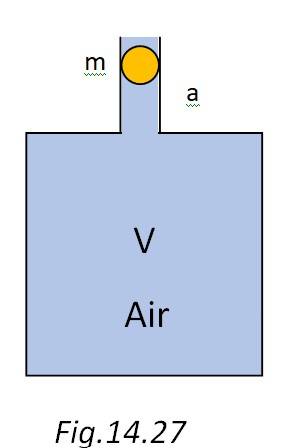
Volume of the air chamber = V
Area of cross-section of the neck = a
Mass of the ball = m
The pressure inside the chamber is equal to atmospheric pressure.
Let the ball be depressed by x units. As a result of depression, there would be decrease in volume and an increase of pressure inside the cylinder.
Decrease in the volume, = ax
Volumetric strain = =
Bulk modulus of air, B = = : here stress is the increase in pressure. The negative sign indicates that pressure increases with a decrease in volume.
So p =
The restoring force acting on the ball, F = p = …. (i)
In SHM, the equation of restoring force, F = -kx …. (ii)
Combining equation (i) and (ii), we get k =
Time period, T = 2 = 2
14.21 You are riding in an automobile of mass 3000 kg. Assuming that you are examining the oscillation characteristics of its suspension system. The suspension sags 15 cm when the entire automobile is placed on it. Also, the amplitude of oscillation decreases by 50% during one complete oscillation.
Estimate the values of
(a) The spring constant k and
(b) The damping constant b for the spring and shock absorber system of one wheel, assuming that each wheel supports 750 kg.
Mass of the automobile, m = 3000 kg
Displacement of the suspension system, x = 15 cm = 0.15 m
There are 4 springs in parallel to the support of the mass of the automobile.
(a) The equation for restoring force for the system, F = -4kx = mg, where k is the spring constant of the suspension system
Time period, T = 2 and
k = = N/m
(b) Each wheel supports a mass, M = 3000/4 = 750 kg
For damping factor b, the equation for displacement is written as
x =
The amplitude of oscillation decrease by 50%. Therefore x = =
=
b =
T = 2 = 2 = 0.7773 s
b = = 1337.32 kg/s
Therefore the damping constant of the spring is 1337.32 kg/s
14.22 Show that for a particle in linear SHM the average kinetic energy over a period of oscillation equals the average potential energy over the same period.
The equation of displacement of a particle executing SHM at an instant t is given bas:
x = Asin , where A = Amplitude of oscillation and = angular frequency =
The velocity of the particle, v = = A
The kinetic energy of the particle = M = M = M
The potential energy of the particle = k = k
For time period T, the average kinetic energy over a single cycle is given as :
= =
= = = = …….(i)
Average potential energy over one cycle is given as :
=
= = = = …….(ii)
From equations (i) and (ii), it is proved that average kinetic energy for a given period of time is equal to the average potential energy for the same period of time.
14.23 A circular disc of mass 10 kg is suspended by a wire attached to its centre. The wire is twisted by rotating the disc and released. The period of torsional oscillations is found to be 1.5 s. The radius of the disc is 15 cm. Determine the torsional spring constant of the wire. (Torsional spring constant is defined by the relation J = – , where J is the restoring couple and the angle of twist).
Mass of the circular disc, m = 10 kg
Radius of the disc, r = 15 cm = 0.15 m
The torsional oscillation of the disc have a time period, T = 1.5 s
The moment of inertia of the disc I = m = = 0.1125
Time period, T = 2 ,
Torsional spring constant, = 1.974 Nm/rad
14.24 A body describes simple harmonic motion with an amplitude of 5 cm and a period of 0.2 s. Find the acceleration and velocity of the body when the displacement is (a) 5 cm (b) 3 cm (c) 0 cm.
Amplitude = 5 cm = 0.05 m
Time period, T = 0.2 s
(a) For displacement x = 5 cm = 0.05m
Acceleration is given by a = = = = 5 m/s
Velocity is given by V = = = 0
(b) For displacement x = 3 cm = 0.03m
Acceleration is given by a = = = = 3 m/s
Velocity is given by V = = = 0.4
(c) For displacement x = 0 cm = 0 m
Acceleration is given by a = = = = m/s
Velocity is given by V = = = 0.5
14.25 A mass attached to a spring is free to oscillate, with angular velocity , in a horizontal plane without friction or damping. It is pulled to a distance and pushed towards the centre with a velocity at time t = 0. Determine the amplitude of the resulting oscillations in terms of the parameters and .
[Hint : Start with the equation x = a cos ( t + ) and note that the initial velocity is negative.]
The displacement equation for an oscillating mass is given by : x = Acos ( , where
A = the amplitude
x = the displacement
Velocity, V = = -A t +
At t = 0, x = , = ….(i)
And = = A …….(ii)
Squaring and adding, we get
, A =
Explore exams which ask questions on physics ncert solutions class 11th
Select your preferred stream
physics ncert solutions class 11th Exam
Student Forum
Other Similar chapters for you
- Physical World
- Units and Measurements
- Motion in a Straight Line
- Motion in a Plane
- Laws of Motion
- Work, Energy, and Power
- System of Particles and Rotational Motion
- Gravitation
- Mechanical Properties of Solids
- Mechanical Properties of Fluids
- Thermal Properties of Matter
- Thermodynamics
- Kinetic Theory
- Oscillations
- Waves
Popular Courses After 12th
Exams accepted
CA FoundationExams accepted
ICSI ExamExams accepted
BHU UET | GLAET | GD Goenka TestBachelor of Business Administration & Bachelor of Law
Exams accepted
CLAT | LSAT India | AIBEExams accepted
IPMAT | NMIMS - NPAT | SET
Exams accepted
BHU UET | KUK Entrance Exam | JMI Entrance ExamBachelor of Design in Animation (BDes)
Exams accepted
UCEED | NIFT Entrance Exam | NID Entrance ExamBA LLB (Bachelor of Arts + Bachelor of Laws)
Exams accepted
CLAT | AILET | LSAT IndiaBachelor of Journalism & Mass Communication (BJMC)
Exams accepted
LUACMAT | SRMHCAT | GD Goenka Test



